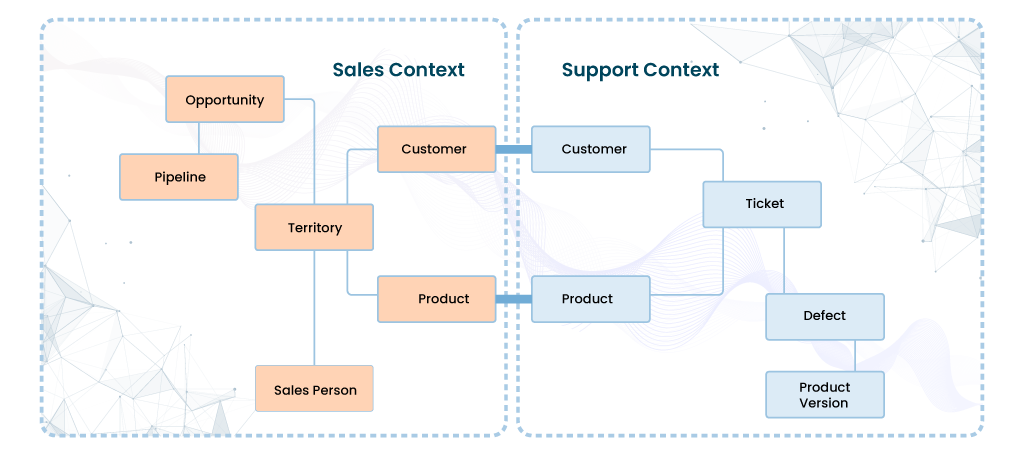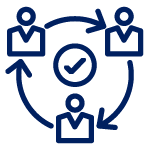A Federated Data Governance Approach: Benefits and Best Practices

As we approach the AI era, the surging demand for data becomes a pivotal point in tech evolution. Success lies in meticulous data governance and shaping a strategy to balance governance with access in the imminent age of innovation. Enter the Federated Model for Modern Data Governance, gaining traction for its shift from central control. This innovative approach involves a cross-section of professionals overseeing data governance, redefining the tech landscape with a transformative and collaborative strategy.
Decoding Federated Governance Approach
In the realm of data governance, a federated approach entails a collaboration between centralized IT and domain-level teams that produce data within their domain. A domain may encompass various facets, such as a line of business, business function, or geography. Domains are defined by Bounded Context, which essentially means that each domain operates with a distinct role and relies on unique terms and rules to accomplish its objectives as efficiently as possible. These rules, terms, and objectives define the boundaries of a domain. For example, Otis Elevator Company sells lifts in the UK domain and elevators in the US domain. This approach ensures a tailored and efficient management of data within diverse operational contexts.

Sales and support domains also have their objectives, rules, and terms. As shown below, the customer and product have different roles in the sales and support contexts. This distinction implies that a customer in the sales domain may have a slightly different meaning than a customer in the support context. Effectively managing this overlap is a pivotal function of federated governance.
In a federated governance approach, the IT and domain-level teams have specific roles. Central IT manages high-level governance policies applicable across domains, enforcing standards to ensure seamless interoperability. On the other hand, domain teams focus on policies specific to the data they collect and manage within their domain.
Essentially, IT creates flexible frameworks that empower domains to manage their data efficiently, aligning with their unique needs while staying within the broader governance framework. This approach is the cornerstone for a modern data mesh architecture, fostering enhanced agility and facilitating broader access to data across the organization.
Navigating the benefits of the Federated Data Governance Approach
Adopting a federated governance approach to data management offers several benefits, particularly in enabling more distributed architectures.
By implementing federated data governance, organizations can establish distributed systems that are not only more agile and innovative but also more efficient and secure.
In contrast to the typical data governance strategies, where IT is responsible for ensuring data security, privacy, accuracy, availability, and usability, federated governance decentralizes this control. The conventional one-size-fits-all approach, though simpler to manage the complexity across domains while ensuring data integrity, can be overly restrictive, hindering legitimate users from accessing valuable data.
The risk-averse nature of IT often results in stringent policies, limiting the accessibility and usability of different datasets. Overly restrictive data governance may inadvertently lead to security vulnerabilities as users find workarounds to policies that do not meet their requirements. In an era where access to reliable data is imperative for organizations, those imposing limitations may find themselves at a competitive disadvantage.
Recognizing that different business functions and geographies have unique policies and regulations, federated governance places those who collect and understand the data best in a much better position to manage the governance rules. For instance, GDPR compliance is relevant only in the European Union, and varying businesses have varying data quality thresholds.

Even within data sets, some columns may contain PII data, while others may not. Federated governance empowers domain teams to manage governance rules based on their intricate knowledge of data nuances and specific business needs. This enables them to apply fine-grained access controls, allowing selective access to sensitive columns within a data set.
For example, in the insurance domain, authorities can mask sensitive columns within a table to grant sales and marketing access without exposing confidential information, facilitating more accurate market segmentations and targeted sales strategies. In financial domains, specific rules governing sensitive financial data can be selectively applied, avoiding unnecessary restrictions on less sensitive information and preserving access to valuable data.
Moreover, domain teams, possessing a deep understanding of data collection processes, also know where their data may have weaknesses or quality issues and, more importantly, why data sets have specific problems. This insight allows them to control how certain professionals use data, limiting access to the specific columns causing the issues.
In essence, a federated governance approach empowers organizations to optimize data access, security, and usability by decentralizing control and aligning governance with the unique requirements of diverse domains.
More autonomy drives greater agility
Empowering business domains with decision-making authority in their areas of expertise brings about enhanced agility in processes. This autonomy allows operators to swiftly adapt to changing needs without seeking permissions from central IT. For example, sales and marketing teams can promptly respond to new opportunities as they no longer require approval from central IT to access pertinent data. This decentralized approach enables R&D teams to explore new datasets by reaching out directly to the more accessible domain teams without waiting to get authorization from central IT.
Given that IT departments are often stretched thin, delegating decision-making to domains not only accelerates processes but also reduces the burden on these teams. Moreover, this greater autonomy also empowers individuals, fostering increased participation and engagement.
Challenges in Implementing Federated Data Governance
While federated data governance promises various benefits, implementing it can be tricky, requiring a well-defined strategy.
The initial challenge lies in clearly defining the roles and responsibilities of each domain. To avoid domain overlap and mitigate conflicts and redundancies, central IT must play a pivotal role in determining which domains are responsible for what datasets.
Maintaining the right balance between limited central governance and the autonomy of domains is crucial for success. Central governance must hold the responsibility of enforcing standards that ensure interoperability across domains. If groups implement different technology stacks that are not interoperable, there is a risk of creating new data silos, negating the purpose of breaking down existing ones.
Ensuring corporate-wide data quality standards is paramount for establishing trust in shared data. These requirements must be defined and enforced by the central IT department. A central technology framework and governance rules need to be established and rigorously enforced.
Best Practices for Seamless Federated Data Governance Implementation
In navigating their journey towards federated data governance, organizations can proactively take concrete steps to ensure a smooth transition.

Create smart but flexible frameworks
Establishing frameworks is key to federated data governance. These frameworks should be smart, catering to the needs of both domains and central IT. The focus should be on figuring out who is in the best position and has the most knowledge to implement the rules best rather than different departments competing for control. Additionally, the frameworks must be adaptable to evolving technology and environment changes to ensure ongoing efficiency.

Standardize conflict resolution processes
As control and authority are distributed across the organization, disputes are inevitable. What happens when multiple domains assert authority over a particular dataset? Before embarking on data federation, a predefined system for resolving disputes must exist, similar to the establishment of a court system in the US Constitution for legal matters.

Create well-articulated and defined responsibilities
With a federated system, authority is distributed across a wide range of individuals. To be successful, these individuals need to understand what their responsibilities are. Documenting roles and responsibilities helps reduce confusion and ensures that each individual understands their specific duties for successful governance.

Maintain a center of excellence
Recognizing that there is no one-size-fits-all federated data governance strategy, organizations should allow for evolution. A center of excellence can serve as a repository for best practices, capturing what works well and identifying areas for improvement. This central hub promotes continuous enhancement of processes across the organization.
A central data mesh platform can be beneficial in supporting a federated data governance strategy. This platform serves as the technological foundation, setting the standard for interoperability. Managing governance controls independently but using similar technology and controls reinforces a federated framework. The platform becomes the mechanism for defining domains, ensuring cohesion and efficiency in the overall governance structure.
Get in touch to unlock the real potential of your data!
Trianz would be pleased to set up Extrica demo for you and conduct proof of value to showcase the benefits of Extrica.

